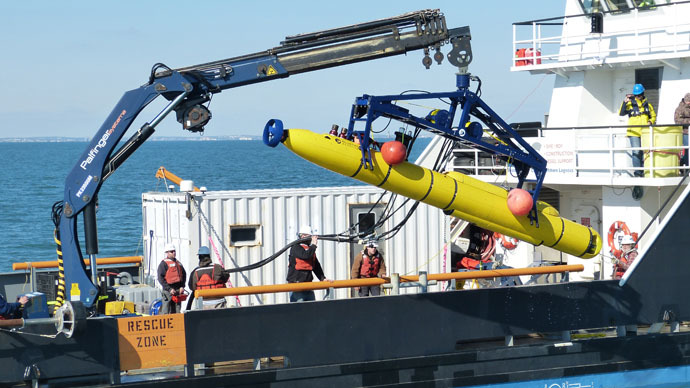DARPA to test 'submarine' drone that takes off from the ocean

This year, the Pentagon’s advanced research projects department will start testing their new “submarine” drone, which can lie in wait on the ocean floor for years before ever being launched into the skies.
The new drones, being developed by the Defense Advanced Research Projects Agency (DARPA), are part of a new focus by the US military in developing and improving technology for emerging threats.
These deployable, unmanned systems and sensors can theoretically lie on the deep-ocean floor for years at time in anticipation of the US Navy’s need for non-lethal assistance. When needed, the deep-sea nodes can be activated remotely and recalled to the surface.
DARPA makes Underwater Attack Drones http://t.co/AEB7YtDSgS#ReleaseTheKraken#DARPA#Drones#TechnologyGoneWild#Anonymous#AnonymousSaveUs
— Jose Prado (@GalanDeLaCalle) April 21, 2014
DARPA will specifically be testing whether the drones can survive for years under extreme pressure before being triggered from a distance, and whether they can rise through a water column and relay information. The tests are part of DARPA’s two phases under its Upward Falling Payloads (UFP) program.
The UFP’s would be equipped with electronic and low-power laser attack capabilities, surveillance sensors, and airborne and aquatic drones that would have the ability to act as decoys or offer intelligence and targeting data.
READ MORE:‘Compromised & gone’: Pentagon lost $500mn of weapons, equipment in Yemen
Much of the testing will be done in the Western Pacific. Nearly 50 percent of the world’s oceans are deeper than 2.5 miles (4km), which provides areas of concealment and storage so assets can remain undetected for long periods of time and still be recalled when needed. The vastness also allows for simultaneous operation across great distances.
“Today, the US Navy puts capability on the ocean floor using very capable but fairly expensive submarine platforms,” said Steven H. Walker, deputy director of DARPA. “What we’d like to do in this program is preposition capability on the ocean floor and have it available to be triggered [in] real time.”
READ MORE: DARPA producing sea-floor pods that can release attack drones on command
The US Navy already uses ocean-faring drones called Slocum Gliders to scan the sea and transmit information – mostly weather and surveillance data – to ships. These drones don’t need fuel to operate, but use ocean currents for propulsion and buoyancy to shift direction.
DARPA released a biennial report last week summarizing its evolving focus to maintain America’s strategic position in the world.
“DARPA’s mission and philosophy have held steady for decades, but the world around DARPA has changed dramatically,” the report says. “Those changes include some remarkable and even astonishing scientific and technological advances … at the same time, the world is experiencing some deeply disturbing technical, economic and geopolitical shifts that pose threats to US preeminence and stability.”
READ MORE:$561bn Pentagon budget planned, advocates say real budget is $1trn
DARPA is seeking a 59 percent increase in the UFP budget, from $11.9 million to 19 million, it was reported in March. But overall, President Barack Obama requested a $3 billion budget for DARPA for the fiscal year 2016, a slight increase over previous years. This would enable the agency to carry out ambitious project in four areas outlined in its biennial report – Rethink Complex Military Systems; Master the Information Explosion; Harness Biology as Technology; and Expand the Technological Frontier.
“The reason we’re able to have this big impact is because we work with and tap the resources of a vast technological ecosystem,” DARPA Director Arati Prabhakar said in a press briefing. “Much is done with universities and companies of every stripe – defense contractors, but also commercial companies as small as startups and as big as major firms.”












